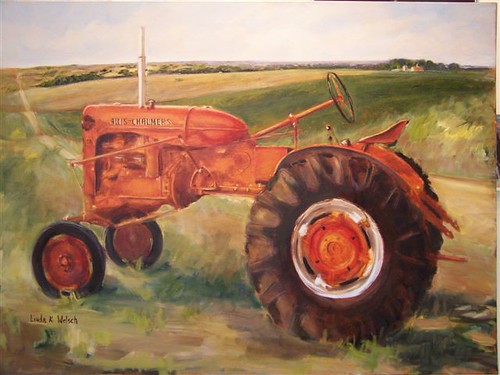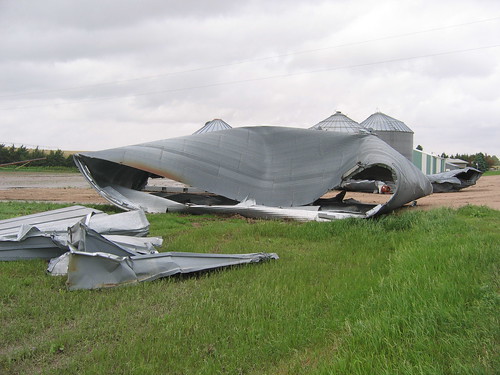 Kent Hubbert shows filtration system for subsurface drip irrigation
Kent Hubbert shows filtration system for subsurface drip irrigationIn my job at Successful Farming and Agriculture Online I have the privilege of being exposed to a lot of ideas from farmers, companies and colleagues. From my travels and desktop hopping, here are ten ideas that struck me as important this year. Please feel free to add your own ideas.
1. Tech clothes for farmers
I started wearing "active moisture management technology" t-shirts for exercise last summer, and found I stayed a lot drier and cooler. This type of clothing is made from material that draws sweat away from the skin and spreads it out over your body to evaporate better and keep you cooler. Same technology exists for socks, jackets and other work clothes for farmers.
http://www.agriculture.com/ag/story.jhtml?storyid=/templatedata/ag/story/data/1210799599376.xml
2. Auto shutoff on planter
It’s just one example of the new auto-everything technology for the field, but I visited a several farms this summer where farmers made a bit of a point telling me how much they liked these systems for shutting off the planter at the end rows.
http://www.agriculture.com/ag/story.jhtml?storyid=/templatedata/ag/story/data/1203976615298.xml&bcpid=1430551123&bclid=1432781673&bctid=1849009648
3. Subsurface drip irrigation
Irrigation tape is buried in field on 60 widths, 14 to 16 inches deep in the soil. A Nebraska farmer told me that he was figuring a five-to-seven year payback on the techonology and was seeing 60 percent fuel and water savings with the system.
http://link.brightcove.com/services/link/bcpid1430551123/bclid1432781673/bctid1589586911
4. Shift up and throttle back
This is probably old hat to most farmers, but it was good reinforcement to see this practice demonstrated at the Nebraska Tractor Test Laboratory this summer, using the newest, biggest tractors and testing equipment. PTO and drawbar tests on tractors proved again that by shifting up and throttling back, you can maintain your power output and save fuel in the process, according to Dave Morgan, assistant director of the lab.
http://www.agriculture.com/AGOL-TV/?cid=507869917&lid=1387524744&tid=1589625225
5. Top Shops
Farmer ideas for designing and improving their farm shops are some of the most popular features on Agriculture Online. Results from a new Top Shops contest are being featured on the site currently. And, the Top Shops TV segment on the Machinery Show, hosted by Dave Mowitz, is the linchpin of the RFD cable network program.
http://www.agriculture.com/ag/story.jhtml?storyid=/templatedata/ag/story/data/1226510126138.xml
6. Ag Connect Expo
A new global farm machinery expo was announced this summer that could change the playing field in farm shows. The first show, slated for January 10-12 in Orlando, promises new, high-tech ways for farmers to connect with companies at the event. And, Ag Connect will appeal to the whole family. Sponsored by the Association of Equipment Manufacturers, the expo has a target of 700 exhibitors, 20,000 visitors in 250,000 square feet of space.
http://insideag.blogspot.com/2008/08/stealing-show.html
7. Cover crops on the rise
Cover crops, such as annual ryegrass, are making a comeback in the Corn Belt, according to Dan Towery, Ag Conservation Solutions, Lafayette, Indiana. At a visit to an Indiana farm using cover crops this summer, Towery told me that annual ryegrass is being grown on more than 400,000 acres in the Midwest. No-tillers are reporting increased corn yields from 20 to 50 bushels per acre, even in dry years, he said. Other cover crops demonstrating good potential include hairy vetch, crimson clover and red clover, according to Penn State research.
http://link.brightcove.com/services/link/bcpid1430551123/bclid1432781673/bctid1849009648
8. Harvesting corn cobs
The ethanol maker, POET, announced in November it was gearing up to generate 25 million gallons of ethanol from corn cobs, starting in 2011. The Sioux Falls-based company wants to start contracting with farmers to harvest cobs as early as 2009 and expects it to be able to pay farmers between $30 and $60 per ton for the by-product. At a recent Iowa event, about a dozen farm equipment companies demonstrated the latest technology for harvesting corn cobs.
http://www.agriculture.com/ag/story.jhtml?storyid=/templatedata/ag/story/data/1226090131944.xml
9. Social networking
Social media sites like Facebook and MySpace are overhauling the Internet, as people continue to replace e-mail, TV, and portal Web sites with these networking experiences. The Farmers for the Future social network, launched only a couple months ago, already has more than 500 members who are doing a great job of sharing ideas, video, photos and friendship.
http://www.farmersforthefuture.com
10. Twitpic
People sometimes kind of snicker when I mention that I like to use the microblogging tool, Twitter. Twitpic is an application that enables you to post photos and text to Twitter. I used the app last summer to update my blog and Web site, needing only my cell phone’s camera and a phone call to Twitpic. Pretty cool to do that straight from a combine cab while talking to a farmer.
http://www.twitpic.com/f7it




















